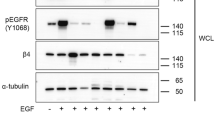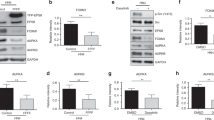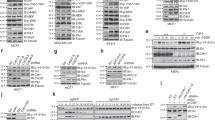Abstract
The receptor-type protein tyrosine phosphatase epsilon (RPTPɛ) activates c-Src in mammary tumor cells induced in vivo by Neu. Tumor cells lacking RPTPɛ exhibit reduced c-Src activity, appear less transformed morphologically and proliferate slower in vitro and in vivo. Expression of Src rescues most of these phenotypes, indicating that c-Src activity is important for maintaining the transformed phenotype. However, the molecular mechanisms that control activation of c-Src by RPTPɛ are unknown. We show that Neu induces phosphorylation of RPTPɛ exclusively at its C-terminal Y695, and that this phosphorylation is required for activation of c-Src by RPTPɛ. Phosphorylation of RPTPɛ does not affect its activity toward another substrate, the voltage-gated potassium channel Kv2.1, suggesting that phosphorylation directs RPTPɛ activity toward c-Src. Phosphorylation of RPTPɛ reduces its dimerization at the cell membrane, although this does not affect its activity significantly. RPTPɛ is subject to strong auto- and trans-dephosphorylation, suggesting that dephosphorylation limits the activation of c-Src downstream of Neu. We conclude that an Neu-RPTPɛ-Src signaling pathway exists in mammary tumor cells, in which phosphorylation of RPTPɛ by Neu directs RPTPɛ to activate c-Src. Reversible phosphorylation of RPTPɛ at Y695 may thus function as a ‘molecular switch’, which affects the substrate specificity of the phosphatase.
This is a preview of subscription content, access via your institution
Access options
Subscribe to this journal
Receive 50 print issues and online access
$259.00 per year
only $5.18 per issue
Buy this article
- Purchase on Springer Link
- Instant access to full article PDF
Prices may be subject to local taxes which are calculated during checkout







Similar content being viewed by others
References
Belsches-Jablonski AP, Biscardi JS, Peavy DR, Tice DA, Romney DA, Parsons SJ . (2001). Src family kinases and HER2 interactions in human breast cancer cell growth and survival. Oncogene 20: 1465–1475.
Bodrikov V, Leshchyns'ka I, Sytnyk V, Overvoorde J, den Hertog J, Schachner M . (2005). RPTPalpha is essential for NCAM-mediated p59fyn activation and neurite elongation. J Cell Biol 168: 127–139.
Boggon TJ, Eck MJ . (2004). Structure and regulation of Src family kinases. Oncogene 23: 7918–7927.
Chen CA, Okayama H . (1988). Calcium phosphate-mediated gene transfer: a highly efficient transfection system for stably transforming cells with plasmid DNA. Biotechniques 6: 632–638.
Chong YP, Mulhern TD, Cheng HC . (2005). C-terminal Src kinase (CSK) and CSK-homologous kinase (CHK) – endogenous negative regulators of Src-family protein kinases. Growth Factors 23: 233–244.
Cole PA, Shen K, Qiao Y, Wang D . (2003). Protein tyrosine kinases Src and Csk: a tail's tale. Curr Opin Chem Biol 7: 580–585.
den Hertog J, Pals CE, Peppelenbosch MP, Tertoolen LG, de Laat SW, Kruijer W . (1993). Receptor protein tyrosine phosphatase alpha activates pp60c-src and is involved in neuronal differentiation. EMBO J 12: 3789–3798.
Elson A, Leder P . (1995a). Identification of a cytoplasmic, phorbol ester-inducible isoform of protein tyrosine phosphatase epsilon. Proc Natl Acad Sci USA 92: 12235–12239.
Elson A, Leder P . (1995b). Protein-tyrosine phosphatase epsilon. An isoform specifically expressed in mouse mammary tumors initiated by v-Ha-ras OR neu. J Biol Chem 270: 26116–26122.
Flint AJ, Tiganis T, Barford D, Tonks NK . (1997). Development of ‘substrate-trapping’ mutants to identify physiological substrates of protein tyrosine phosphatases. Proc Natl Acad Sci USA 94: 1680–1685.
Gil-Henn H, Elson A . (2003). Tyrosine phosphatase-epsilon activates Src and supports the transformed phenotype of Neu-induced mammary tumor cells. J Biol Chem 278: 15579–15586.
Gil-Henn H, Volohonsky G, Elson A . (2001). Regulation of protein-tyrosine phosphatases alpha and epsilon by calpain-mediated proteolytic cleavage. J Biol Chem 276: 31772–31779.
Gil-Henn H, Volohonsky G, Toledano-Katchalski H, Gandre S, Elson A . (2000). Generation of novel cytoplasmic forms of protein tyrosine phosphatase epsilon by proteolytic processing and translational control. Oncogene 19: 4375–4384.
Granot-Attas S, Elson A . (2004). Protein tyrosine phosphatase epsilon activates Yes and Fyn in Neu-induced mammary tumor cells. Exp Cell Res 294: 236–243.
Guo S, Ferl GZ, Deora R, Riedinger M, Yin S, Kerwin JL et al. (2004). A phosphorylation site in Bruton's tyrosine kinase selectively regulates B cell calcium signaling efficiency by altering phospholipase C-gamma activation. Proc Natl Acad Sci USA 101: 14180–14185.
Guy CT, Muthuswamy SK, Cardiff RD, Soriano P, Muller WJ . (1994). Activation of the c-Src tyrosine kinase is required for the induction of mammary tumors in transgenic mice. Genes Dev 8: 23–32.
Harder KW, Moller NP, Peacock JW, Jirik FR . (1998). Protein-tyrosine phosphatase alpha regulates Src family kinases and alters cell-substratum adhesion. J Biol Chem 273: 31890–31900.
Kim H, Chan R, Dankort DL, Zuo D, Najoukas M, Park M et al. (2005). The c-Src tyrosine kinase associates with the catalytic domain of ErbB-2: implications for ErbB-2 mediated signaling and transformation. Oncogene 24: 7599–7607.
Klinghoffer RA, Sachsenmaier C, Cooper JA, Soriano P . (1999). Src family kinases are required for integrin but not PDGFR signal transduction. EMBO J 18: 2459–2471.
Lau KH, Wu LW, Sheng MH, Amoui M, Suhr SM, Baylink DJ . (2006). An osteoclastic protein-tyrosine phosphatase is a potential positive regulator of the c-Src protein-tyrosine kinase activity: a mediator of osteoclast activity. J Cell Biochem 97: 940–955.
Luttrell DK, Lee A, Lansing TJ, Crosby RM, Jung KD, Willard D et al. (1994). Involvement of pp60c-src with two major signaling pathways in human breast cancer. Proc Natl Acad Sci USA 91: 83–87.
Maksumova L, Le HT, Muratkhodjaev F, Davidson D, Veillette A, Pallen CJ . (2005). Protein tyrosine phosphatase alpha regulates Fyn activity and Cbp/PAG phosphorylation in thymocyte lipid rafts. J Immunol 175: 7947–7956.
Meyer RD, Dayanir V, Majnoun F, Rahimi N . (2002). The presence of a single tyrosine residue at the carboxyl domain of vascular endothelial growth factor receptor-2/FLK-1 regulates its autophosphorylation and activation of signaling molecules. J Biol Chem 277: 27081–27087.
Muller WJ, Sinn E, Pattengale PK, Wallace R, Leder P . (1988). Single-step induction of mammary adenocarcinoma in transgenic mice bearing the activated c-neu oncogene. Cell 54: 105–115.
Mustelin T, Hunter T . (2002). Meeting at mitosis: cell cycle-specific regulation of c-Src by RPTPalpha. Sci STKE 2002: PE3.
Muthuswamy SK, Muller WJ . (1995a). Activation of Src family kinases in Neu-induced mammary tumors correlates with their association with distinct sets of tyrosine phosphorylated proteins in vivo. Oncogene 11: 1801–1810.
Muthuswamy SK, Muller WJ . (1995b). Direct and specific interaction of c-Src with Neu is involved in signaling by the epidermal growth factor receptor. Oncogene 11: 271–279.
Muthuswamy SK, Siegel PM, Dankort DL, Webster MA, Muller WJ . (1994). Mammary tumors expressing the neu proto-oncogene possess elevated c-Src tyrosine kinase activity. Mol Cell Biol 14: 735–743.
Pallen CJ . (2003). Protein tyrosine phosphatase alpha (PTPalpha): a Src family kinase activator and mediator of multiple biological effects. Curr Top Med Chem 3: 821–835.
Pera IL, Iuliano R, Florio T, Susini C, Trapasso F, Santoro M et al. (2005). The rat tyrosine phosphatase eta increases cell adhesion by activating c-Src through dephosphorylation of its inhibitory phosphotyrosine residue. Oncogene 24: 3187–3195.
Peretz A, Gil-Henn H, Sobko A, Shinder V, Attali B, Elson A . (2000). Hypomyelination and increased activity of voltage-gated K(+) channels in mice lacking protein tyrosine phosphatase epsilon. EMBO J 19: 4036–4045.
Ponniah S, Wang DZ, Lim KL, Pallen CJ . (1999). Targeted disruption of the tyrosine phosphatase PTPalpha leads to constitutive downregulation of the kinases Src and Fyn. Curr Biol 9: 535–538.
Roskoski Jr R . (2005). Src kinase regulation by phosphorylation and dephosphorylation. Biochem Biophys Res Commun 331: 1–14.
Su J, Muranjan M, Sap J . (1999). Receptor protein tyrosine phosphatase alpha activates Src-family kinases and controls integrin-mediated responses in fibroblasts. Curr Biol 9: 505–511.
Tiran Z, Peretz A, Attali B, Elson A . (2003). Phosphorylation-dependent regulation of Kv2.1 channel activity at tyrosine 124 by Src and by protein-tyrosine phosphatase epsilon. J Biol Chem 278: 17509–17514.
Toledano-Katchalski H, Elson A . (1999). The transmembranal and cytoplasmic forms of protein tyrosine phosphatase epsilon physically associate with the adaptor molecule Grb2. Oncogene 18: 5024–5031.
Toledano-Katchalski H, Tiran Z, Sines T, Shani G, Granot-Attas S, den Hertog J et al. (2003). Dimerization in vivo and inhibition of the nonreceptor form of protein tyrosine phosphatase epsilon. Mol Cell Biol 23: 5460–5471.
Tracy S, van der Geer P, Hunter T . (1995). The receptor-like protein-tyrosine phosphatase, RPTP alpha, is phosphorylated by protein kinase C on two serines close to the inner face of the plasma membrane. J Biol Chem 270: 10587–10594.
von Wichert G, Jiang G, Kostic A, De Vos K, Sap J, Sheetz MP . (2003). RPTP-alpha acts as a transducer of mechanical force on alphav/beta3-integrin-cytoskeleton linkages. J Cell Biol 161: 143–153.
Zeng L, Si X, Yu WP, Le HT, Ng KP, Teng RM et al. (2003). PTP alpha regulates integrin-stimulated FAK autophosphorylation and cytoskeletal rearrangement in cell spreading and migration. J Cell Biol 160: 137–146.
Zheng XM, Resnick RJ, Shalloway D . (2000). A phosphotyrosine displacement mechanism for activation of Src by PTPalpha. EMBO J 19: 964–978.
Zheng XM, Resnick RJ, Shalloway D . (2002). Mitotic activation of protein-tyrosine phosphatase alpha and regulation of its Src-mediated transforming activity by its sites of protein kinase C phosphorylation. J Biol Chem 277: 21922–21929.
Zheng XM, Shalloway D . (2001). Two mechanisms activate PTPalpha during mitosis. EMBO J 20: 6037–6049.
Zheng XM, Wang Y, Pallen CJ . (1992). Cell transformation and activation of pp60c-src by overexpression of a protein tyrosine phosphatase. Nature 359: 336–339.
Acknowledgements
We thank colleagues mentioned in the text for gifts of valuable reagents. This study was supported by the Israel Cancer Research Fund, the Minerva Foundation (Munich, Germany), and the Women's Health Research Center at the Weizmann Institute.
Author information
Authors and Affiliations
Corresponding author
Additional information
Supplementary Information accompanies the paper on the Oncogene website (http://www.nature.com/onc).
Supplementary information
Rights and permissions
About this article
Cite this article
Berman-Golan, D., Elson, A. Neu-mediated phosphorylation of protein tyrosine phosphatase epsilon is critical for activation of Src in mammary tumor cells. Oncogene 26, 7028–7037 (2007). https://doi.org/10.1038/sj.onc.1210505
Received:
Revised:
Accepted:
Published:
Issue Date:
DOI: https://doi.org/10.1038/sj.onc.1210505
Keywords
This article is cited by
-
Protein tyrosine phosphatases: promising targets in pancreatic ductal adenocarcinoma
Cellular and Molecular Life Sciences (2019)
-
Synapse formation regulated by protein tyrosine phosphatase receptor T through interaction with cell adhesion molecules and Fyn
The EMBO Journal (2009)
-
Protein tyrosine phosphatase epsilon and Neu-induced mammary tumorigenesis
Cancer and Metastasis Reviews (2008)



